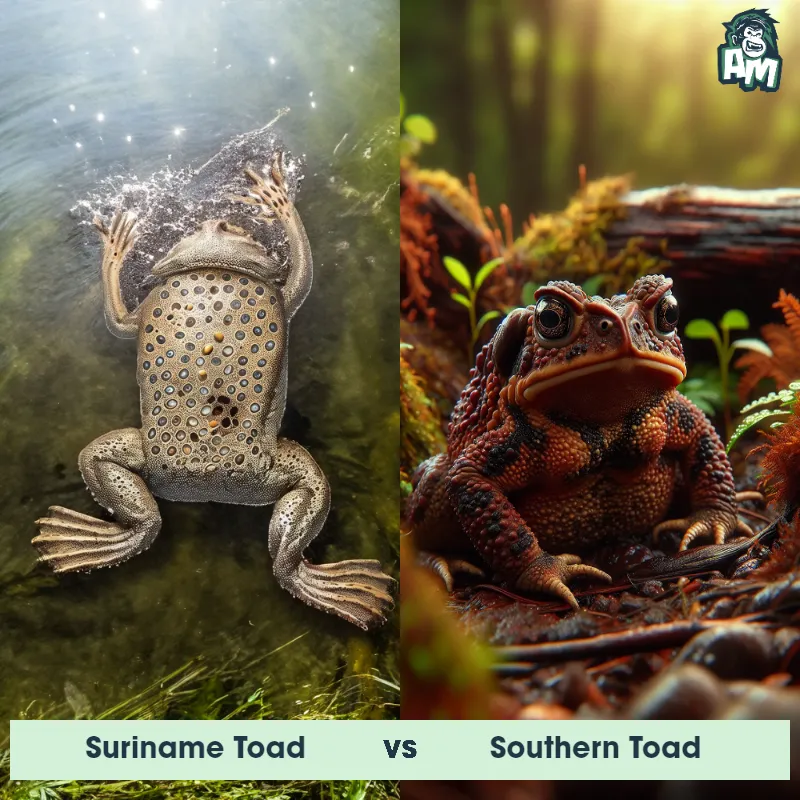Suriname Toad vs Cane ToadSee Who Wins

Welcome to the exciting matchup between the Suriname Toad and the Cane Toad. These two amphibians are ready to go head to head in a fierce battle of strength and agility. Let's see who will come out victorious in this three-round fight!
Contender 1: Suriname Toad
The Suriname Toad, also known as the Star-Fingered Toad, is a unique amphibian found in South America. It has a flattened body and webbed hands and feet, resembling a leaf as it lies still on the bottom of the water. This toad is known for its unusual reproductive behavior, where the female carries eggs on her back until they hatch into fully formed tadpoles.
Fun Fact: One fun fact about the Suriname Toad is that during mating, the male grasps the female's back and inseminates her as she arches her back to release the eggs, a process known as amplexus.
Contender 2: Cane Toad
The Cane Toad, also known as the Bufo marinus, is a large, terrestrial amphibian that can grow up to 9 inches in length. They have dry, warty skin that is typically brown or gray in color, with a creamy underbelly. Cane Toads are known for their distinctive parotoid glands located behind their eyes, which secrete a toxic substance that can be harmful to predators. They are native to Central and South America but have been introduced to other parts of the world, including Australia, where they are considered an invasive species.
Fun Fact: Cane Toads were introduced to Australia in the 1930s in an attempt to control the population of beetles that were damaging sugar cane crops, but the plan backfired as the toads had no natural predators and began to spread rapidly, causing harm to native wildlife.
Matchup Stats
| Suriname Toad | Cane Toad | |
|---|---|---|
| Size | Approximately 4-6 inches (10-15 cm) | Up to 9 inches (22.86 cm) |
| Weight | Around 4-6 ounces (113-170 grams) | Up to 4 pounds (1.81 kg) |
| Speed | 8mph (13km/h) | Speed: 5 mph (8 km/hr) |
| Key Strength | Adaptation for camouflage and defense through its unique appearance | Parotoid glands secrete toxic substance |
| Biggest Weakness | Slow-moving and vulnerable when out in the open | Slow movement |
Current Votes
Suriname Toad vs Cane Toad
See Who Wins
View More Matches
Looking For More?
Similar Matches
Scientific Stats
| Suriname Toad | Cane Toad | |
|---|---|---|
| Scientific Name | Pipa pipa | Bufo marinus |
| Family | Pipidae | Bufonidae |
| Habitat | Freshwater habitats such as ponds, slow-moving streams, and flooded forests | Terrestrial |
| Geography | South America, particularly in countries like Suriname, Venezuela, and Brazil | Native to Central and South America, introduced to other parts of the world |
| Diet | Carnivorous, feeding on insects, small fish, crustaceans, and aquatic invertebrates | Insects, small animals, plants |
| Lifespan | 10 years - 15 years | 5 years - 10 years |
Key Differences between Suriname Toad and Cane Toad
- Size: The Suriname Toad is significantly smaller than the Cane Toad, with adults reaching lengths of only 4-6 inches compared to the Cane Toad's 4-9 inches.
- Limb length: The Suriname Toad has short, stubby limbs with webbed toes, suited for its aquatic lifestyle, while the Cane Toad possesses longer limbs with distinct finger pads for climbing and digging.
- Habitat preference: The Suriname Toad primarily inhabits freshwater habitats such as ponds and slow-moving streams, while the Cane Toad is more adaptable, inhabiting a variety of habitats ranging from tropical rainforests to urban areas.
- Head shape: The Suriname Toad has a relatively flat and wide head compared to the Cane Toad's more triangular-shaped head with distinct crests behind its eyes.
- Coloration: The Suriname Toad is typically mottled brown or gray in color, blending in with its environment, whereas the Cane Toad exhibits more vibrant colors such as olive green, gray, and reddish-brown.
- Skin texture: The Suriname Toad has a distinctive rough and bumpy skin texture, while the Cane Toad has smoother skin with prominent warts scattered on its back.


























